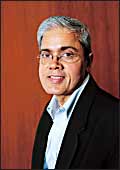 |
| In search of lost glory: Ajit Nambiar,
CMD, BPL |
Dynamic
house, the operational group headquarters of the forgotten giant
of consumer electronics and home appliances, the BPL Group, is beginning
to breathe again. One of the most recognisable Indian brands in
the late 1990s, BPL has fallen on bad times ever since. After what
seemed an eternity, a master plan to rejuvenate the group's spiralling
fortunes has been worked out, and 41-year-old Ajit Nambiar, Chairman
and Managing Director of BPL, pronounces confidently: "BPL
is back."
It may be a trifle early to say that though.
With just 5.5 per cent marketshare in its core colour TV business
(see The BPL Story) in 2003-04, a far cry from a high of 21 per
cent in 2000-01 when it was the undisputed market leader, and far
behind current market leader LG (20 per cent), BPL is in for a long
haul to justify its CMD's confidence.
It's a classic case of a winner who forgot
how to win. Showing the traits of a natural leader, BPL, a conglomerate
of disparate businesses encompassing television sets, refrigerators,
alkaline batteries, rechargeable lanterns, telephones and mobile
phones services among others, identified the great Indian consumer
electronics opportunity as far back as in 1982. Taking advantage
of the growing numbers and aspirations of the middle class, the
group saw its turnover of Rs 456 crore in 1993 multiply four-fold
in a span of just five years, reaching Rs 1,940 crore by 1998-99.
But things started going wrong soon after.
BPL failed to read changing consumer preferences for latest technologies,
and in late 2002, Korean giant LG took over market leadership in
the colour tv market. Since then, BPL has been on a path of continuous
slide, with declining marketshares, shrinking top lines and red
bottom lines. In its core business of colour TV sets, BPL today
sells less than half the one million sets it sold in 2000.
AJIT NAMBIAR'S GAMEPLAN
Ajit Nambiar, CMD of BPL, has lined up a
multi-pronged strategy to revive the group's fortunes. |
» Restructure
the organization into five dedicated businesses
» Restructure
the Rs 1,200-crore debt burden with Rs 322-crore cash from Sanyo
» Negotiate
one-time settlements with creditors for the remaining debt
» Offload
equity in areas like batteries and health care
» Consolidate
CTV business with Sanyo
» Strengthen
the business in health care and engineering and manufacturing
services
» Launch
state-of-the-art digital entertainment products such as DVDs,
digital cameras and MP3 players
» Launch
mobile phones with innovative features
» Provide
bundled schemes of mobile phones with BPL Mobile connections
» Unleash
a Rs 70-crore advertising campaign |
BPL's Cup Of Woes
What started the slide was the entry of the
two Korean giants, LG and Samsung, who had global sourcing capabilities
and were able to raise money at cheaper interest rates internationally.
BPL, on the other hand, had to borrow at exorbitant interest rates
from the marketplace for its requirements. Nambiar acknowledges
the disparity: "Our Korean rivals could borrow at less than
3 per cent in their market and invest here. Some of our borrowings
were at rates as high as 24 per cent." Net result: despite
having invested between Rs 650 and Rs 700 crore in brand building,
and Rs 800 crore in creating manufacturing capacity over the previous
10 years, it could not match the aggression and discounts that the
Koreans could offer. Worse, today BPL is saddled with debts running
up to Rs 1,240 crore, with interest outgo of Rs 220 crore, a daunting
figure for a company in financial distress.
But market conditions can't be blamed for all
of BPL's woes. For instance, the Koreans put their money on advanced
technology products, such as flat-screen TVs, on a value-for-money
platform to further marketshare. And though BPL had the technology
to match its rivals, it continued to plug conventional TV sets.
Consumers, however, were increasingly looking at higher-priced and
higher margin flat TV sets with more features. A recent ORG-GFK
study points out that while 21-inch flat television sets saw a volume
growth of 105 per cent in 2003 compared to 2002, conventional TVs
in the same category declined by 11 per cent. The latent need was
there, which the Korean players clearly identified and exploited.
BPL chose not to, and was left ruing its decision.
Nambiar was also too trusting of the professionals
working in the group. A B.S. in electrical engineering from Boston
University, he was 23 when he was inducted into Electronic Research
Limited, one of the group's numerous companies, in 1985. Between
1993 and 1999, when he was MD of BPL Ltd., he ran the company along
with his father, T.P.G. Nambiar, the founder of the group. After
Ajit became CMD of BPL Ltd. in November 1999, he delegated a lot
of responsibility to subordinates and did not get into minutiae,
unlike his father.
That proved his undoing, as the company's fortunes
nosedived. Says a former director of BPL: "For a family-run
group, this was suicidal. While TPG knew whom to trust and when
to delegate, he would still retain overall control. Ajit expects
everybody to be on the same ethics code as him." Nambiar admits
his folly, but prefers to put that behind him: "I empower individuals
and expect them to deliver. There might have been some who have
misused that trust. But all that is in the past." His determination
to look ahead is evident as he lines up a series of initiatives
to bring the BPL group back into the running.
 |
"Even now the BPL brand
shares the top spot (with LG) in top-of-mind awareness"
Jayanth Kumar/ Advisor/BPL
Group |
The Way Back
As a first step, Nambiar has restructured the
group into five dedicated businesses to achieve better focus: soft
energy (batteries, rechargeable lanterns, etc.), health care, digital
entertainment products, engineering and manufacturing services,
and wireless communication solutions. Next step: address the festering
issue of its debt burden. After 18 months of negotiations, BPL recently
entered into a 50:50 joint venture with the $22-billion (over Rs
1 lakh crore) Japanese consumer electronics giant Sanyo Electronics.
The CTV business of BPL, valued at $80 million (Rs 370 crore), was
transferred to the new JV. Since the JV has been initially capitalised
at $20 million (Rs 92 crore), BPL would pay only $10 million (Rs
46 crore) for a 50 per cent stake; the remaining $70 million (Rs
322 crore) will go to BPL. This money will be used to restructure
its Rs 1,240-crore debt. For the remaining debt, BPL is talking
with its creditors to go in for one-time settlement. For additional
funds, BPL may offload part of its equity in certain areas of its
business, such as health care and soft energy.
Once the debt restructuring is over, the other
parts of Nambiar's strategy will come into play. Utilising the technology
leadership of Sanyo, BPL plans to launch a series of state-of-the-art
products including home theatres, digital cameras, mp3 players,
digital printers and mobile phones. A major area of thrust will
be mobile phones. While BPL is non-existent in the hand phone segment
at present, it has already successfully test-marketed its phones
in UP, Punjab and Kerala, with a view to hit the markets by October.
Nambiar expects to sell four lakh phones and earn Rs 137 crore in
the first year itself. That's a tough ask, but part of his optimism
springs from the fact that the group's mobile phone services company,
BPL Mobile Communications Ltd. run by his brother-in-law Rajeev
Chandrashekar, straddles four major circles including Mumbai, Tamil
Nadu, Kerala and Maharashtra. The strategy: Offer bundled schemes
with every new connection, and put in innovative features relevant
to Indians like, say, a local language menu.
Despite the difficulties, one positive BPL
can go ahead with is the awareness of the brand in consumer consciousness,
an outcome of the huge amount of money spend on advertising in the
1990s. Jayanth Kumar, former CEO of BPL Ltd. and now an advisor
to the group, says, "Even now the BPL brand shares the top
spot (with LG) in top-of-mind awareness." An additional Rs
60-70 crore in advertising will look to stimulate that awareness.
But even as BPL has woken up to the benefits
of latest technologies, LG and Samsung have already moved on to
the next generation TV technology, flat panel TVs, comprising LCD,
LCD Projection and Plasma TVs. BPL has a lot of catching up to do,
but Nambiar is confident: "We are working hard to bring back
the old glory. By this festival season (October), BPL will be back
in full swing." To make that a success, changing the consumer
perception of BPL being an "also-ran" will be the most
formidable obstacle that Nambiar has to overcome.
|
